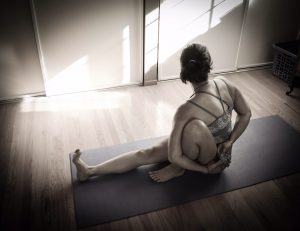The “Why”
Earlier this week, I was asked “Why do you like Ashtanga Yoga?” The question was not an inquiry on my love of yoga but rather my choice in style or “method” as noted by the Ashtanga community. My reply was a quick, not fully well-thought out answer. I simply said because I can practice at my own pace and easily attend to injuries. But that’s only the tip of the iceberg.
When I first began “doing” yoga, I gravitated towards the heated vinyasa classes. I was there for a work out and sought out the teachers that would give me the biggest arse kicking I could get. My first teacher was no dummy. She gave us what we came for but, as we became drenched in sweat, she continually doused us with inquiries of a spiritual and emotional nature. By the time we settled into savasana, we were thoroughly cooked (physically, emotionally, and spiritually). It was great.
 That same teacher introduced me to Ashtanga. There was a group of about twenty who took her “Introduction to Ashtanga class” in preparation for a full-blown mysore style program to start at the studio. She planted the seeds and they immediately began taking root. I did a self practice at home, trying to be worthy of entering the program. I couldn’t jump through or jump back, and I wasn’t at all certain about the rest of the practice either. Notice my Marichyasana C has a nice bind but I’m doing it all wrong; the spine is supposed to rotate in the other direction with the other arm doing the wrapping.
That same teacher introduced me to Ashtanga. There was a group of about twenty who took her “Introduction to Ashtanga class” in preparation for a full-blown mysore style program to start at the studio. She planted the seeds and they immediately began taking root. I did a self practice at home, trying to be worthy of entering the program. I couldn’t jump through or jump back, and I wasn’t at all certain about the rest of the practice either. Notice my Marichyasana C has a nice bind but I’m doing it all wrong; the spine is supposed to rotate in the other direction with the other arm doing the wrapping.
Although I still came for the weekly vinyasa classes, I somehow knew that there was something deeper for me in the Ashtanga practice. It was just a sense; I had nothing tangible to back it up. And still, I insisted it was true well before I braved the Mysore Room. My boyfriend thought I was crazy, pointing out the numerous forward folds in the practice and citing my struggles with chronic back pain.
By the time I braved the room, I hadn’t progressed any further in gaining the knowledge that I thought was needed to be a good mysore student. My teacher, Erika, took what I thought I knew, and customized it for me. Basically, she modified the way I practiced even the simplest of asanas so that my practice was more therapeutic for my back. For example, I placed two blocks at the top of my mat and placed my hands on the blocks when I did the forward folds in the sun salutations. I used a block in many of the standing poses, such as trikonasana, as well. This went against my tendency to power through the practice and I initially felt like I was being forced to be a beginner again (which I was — but, after surviving those arse-kicking vinyasa classes, somehow felt that I was more intermediate level). The result was humbling and definitely revealed my lifelong fear of being “not good enough”. It was quite a mind game and would definitely not be the last. The funny thing was that these modifications, which seemed to make the pose easy, actually forced me to engage my muscles in places where I had simply been bypassing with a misaligned, athlete-minded way of doing yoga. I began learning about my body in a whole new way. On a physical level, I learned that although my spine has odd curves due to scoliosis I can still move toward equanimity by learning to engage the needed muscles and relax the muscles that are not needed.
That was just the beginning. Through the years, I have learned A LOT. For example:
- There is a difference between teetering “the edge” and going beyond our “limitations.”
- There is a difference between discomfort and pain.
- There is “the truth” and there are the “stories” you have bought into throughout your life.
- The processing of breaking lifelong patterns is HARD.
Although the physical practice is the same set of asanas, each day the practice unfolds differently. My practice is not “good” or “bad”; it just is. It is physical but it is NOT a workout. As Mojdeh, my Sunday teacher often tells her students in the all-comers Led Primary, “If you are here for a workout, you are in the wrong place. You can go to 24 hour Fitness or another gym for that.” Those of us who do the Ashtanga practice every day, laugh in the back of the room when she says that. We also laugh when she says that the Ashtanga practice is “boring.” We know better; it is far from boring. It’s hard to explain. I honestly think that you just have to experience it to understand.
Any way, this just skims the surface of the “Why” I love the Ashtanga Yoga Method.
** If YOU practice yoga, please leave a comment to say what styles/methods of yoga you enjoy most and WHY. ~Namaste**
